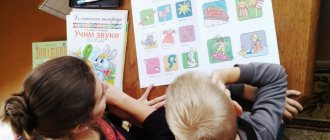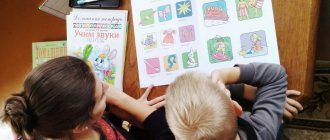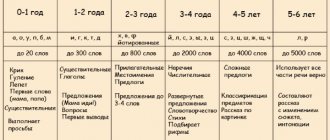Speech therapy examination
LogoKot presents a system for examining children with speech disorders. The program includes the following areas of examination:
- Sound pronunciation survey
- Examination of the structure of the articulatory apparatus and Examination of articulatory motility
- Phonemic Awareness Test
- Examination of the syllable structure of a word
- Vocabulary Survey
- Examination of grammatical structure
- Examination of coherent speech.
The Internet program provides for processing the results of the examination, calculating the points scored by the child as a result of the examination, and issuing a speech therapy report. The results of the examination are documented in a speech card. The speech card is saved in LogoKot in the speech therapist’s personal account. The speech therapist can then save the speech map to his computer (instructions on how to save the web page are available here). The speech card can be easily processed to display other specialist documents: characteristics of the child, referrals for MPT, etc.
The program uses a leveled approach to diagnosing speech underdevelopment. The scores that a child gains as a result of the examination indicate the state of speech development. The program, based on the results of the points scored, offers options for a speech therapy conclusion. The teacher can reasonably write a conclusion, and also monitor the results of correctional work during further examinations.
1. Examination of sound pronunciation:
In the section “Survey of sound pronunciation” the following groups of sounds are examined: whistling (s, s'z, z', ts), hissing (sh, zh, h, sch), sonorant (l, l', r, r), back-lingual ( k, g, x).
The child is asked to name the pictures; if he names the sound in the pictures correctly, the speech therapist continues examining other sounds and presses the “no error” button. If the child makes a mistake (the sound is missing, replaced or distorted), then the speech therapist presses the “error” button and continues the examination.
When examining sound pronunciation, two options are possible: the sound is impaired / the sound is not impaired. Each incorrectly pronounced sound is scored 1 point.
2. Examination of articulatory motor skills
The identification of the characteristics of articulatory motor skills is carried out in the process of the child performing certain actions at the direction of the speech therapist. Includes:
- Study of lip mobility.
- Study of tongue mobility.
- Study of lower jaw mobility.
- Study of the mobility of the soft palate.
When performing tasks, difficulties in the movements of the articulatory organs are diagnosed: obvious impossibility, significant limitation in the range of movements, a tendency to constantly hold the tongue in a “clump” in the depths of the oral cavity, difficulties in changing the given position of the speech organs, tremor, hyperkinesis, synkinesis, slowing down the pace with repeated movements. When analyzing the state of articulatory motor skills, the following parameters can be taken as a basis:
- Movements of the articulatory apparatus: active, passive.
- Range of motion: full, incomplete.
- Muscle tone: normal, flaccid, overly tense.
- Accuracy of movements: accurate, consistent, inaccurate, no sequence of movements.
- The presence of accompanying and violent movements.
- Rate of movement: normal, slow, fast.
- Duration of holding articulators in a certain position.
Based on the results of the examination of articulatory motor skills, the level is determined.
3. Examination of the structure of the articulatory apparatus
Includes:
- Lip examination.
- Dental examination.
- Bite examination.
- Language research.
- Examination of the hard and soft palate.
- Examination of the lower jaw.
The examination reflects the structural features of the articulatory apparatus: normal, mild deviations, gross deviations.
4. Phonemic Awareness Test
Includes:
- Study of the state of physiological hearing.
- Study of differentiation of non-speech sounds.
- Study of the discrimination of syllables and words with oppositional sounds.
- Study of phonemic analysis and synthesis (in children over four years old).
5. Examination of the syllable structure of a word
The examination of the syllabic structure of a word is carried out according to Markova classes.
6. Vocabulary examination
Vocabulary examination is carried out according to the following parameters:
- Study of generalizing concepts.
- A study of occupational understanding.
- Exploring the understanding of shapes and colors of figures.
- Study how a child can form words.
- Other
7. Examination of grammatical structure
The examination of grammatical structure is carried out according to the following parameters:
- Research on the formation of multiple forms.
- Study of the formation of diminutive forms.
- Study of the use of prepositions.
- Study of sentence construction.
- A study of the formation of nouns in oblique cases. Prepositional case forms.
- Study of numeral-noun agreement.
- 7. Research on understanding the names of baby animals
8. Examination of coherent speech.
The story is assessed taking into account:
- its correspondence to the depicted situation (presence of distortions, additions);
- integrity (the presence of all semantic links);
- correct sequence;
- smoothness of presentation: conveys the content without stops, long pauses, additional words (for example: “Well, what’s next?”, etc.);
- understanding the content of what is being presented;
- completeness of the retelling (presence of omissions);
- the nature of language design (grammatical correctness of sentences);
- the method of performing the task (independently or with the help of an experimenter);
Rationale for speech therapy report
Based on the results of the examination and based on the number of points scored by the child, a conclusion is given about the state of speech development of each child. As a result of a complete examination of the child, the following conclusions may be made:
First level (low, 56-67 points) – General underdevelopment of speech OHP level I. Speech as a communicative function is absent.
Second level (below average, 43-55 points) – General underdevelopment of speech OHP level II. Speech activity has increased, but speech does not fulfill its role as a communicative function.
Third level (average, 21-42 points) – General speech underdevelopment OHP level III. The speech is understandable, however, there are lexico-grammatical, phonetic-phonemic disorders and, in general, unformed coherent speech.
Level four (above average, 5-20 points) – Phonetic-phonemic underdevelopment - along with a violation of the phonetic side of speech, there is also underdevelopment of phonemic processes: phonemic perception (auditory differentiation of sounds), phonemic analysis and synthesis, phonemic representations. Perhaps, most often as a result of speech therapy: mild general speech underdevelopment (GUSD) or general speech underdevelopment GSD level IV; In the absence of sound pronunciation disorders, the following conclusion is possible: lexico-grammatical underdevelopment of speech (LGNR - children have normal sound pronunciation, phonemic processes are relatively preserved (most often as a result of speech therapy), but there is a limited vocabulary, a violation of the grammatical structure of speech).
Fifth level (high, less than 4 points) – Normal speech development is possible. In the presence of impaired sound pronunciation, a phonetic speech disorder (FSD) or a violation of the pronunciation of individual sounds (NPOS) is possible.
This form of recording the results obtained, a level approach to assessing the results of the study, allows you to correctly draw a conclusion about the state of the child’s speech development, and reliably monitor the dynamics of correction of the speech defect not only in one specific child, but also in the group as a whole.
The results of the examination are documented in a speech card.
Log in to the service to get full access to the knowledge base
Contents of a speech therapy examination of a child at PMPK
Contents of a speech therapy examination of a child at PMPK
The qualifications of such a component as speech development are assigned to the speech therapist teacher.
Purpose of speech therapy examination
— identification of violations of various components of the speech system, their nature, depth and degree, as well as compensatory capabilities; determining the route of individual development.
Objectives of speech therapy examination:
Diagnostics of the level of formation of different aspects of speech;
In-depth study of the shortcomings of certain components of the speech system, analysis of the qualitative specifics of speech development deficiency;
Identifying compensatory opportunities, predicting the success of training at subsequent stages;
Statement of the general level of speech development, the specifics of disorders to determine the program and forms of training, the route of individual speech therapy work.
Each child should be examined individually, depending on the nature and severity of the speech disorder, with selective use of standard speech therapy tasks.
During a speech therapy examination of a child, a systematic approach to the analysis of speech disorders should be fully used: not only the impaired component of speech activity is identified, but also its relationship with other disorders or intact components of speech. It must be remembered that speech disorders can appear selectively against the background of normal intelligence and intact sensory functions (auditory and visual). If a violation of any component of speech is detected, it is necessary to check the degree of possible violation of other speech processes dependent on it. The manifestation of speech disorders can be both a cause and a consequence of any other disorders.
When choosing tasks, it is necessary to take into account the normal state of speech development for the child’s age.
When conducting a speech therapy examination, the following methods are used:
Studying documentation;
Conversation method;
Speech therapy testing;
Observation method.
Before starting the examination, the speech therapist must study all documents (characteristics, expert opinions). A preliminary analysis of documents allows the speech therapist to build a hypothesis for his examination in order to identify speech problems.
It is advisable to begin the speech therapy examination procedure with a conversation. During the conversation, it becomes clear what the child’s speech environment is like, whether he is aware of his speech deficiency (if any) and how he reacts to it. Have parents contacted a speech therapist before, what correctional work was carried out and what was its result. Before examining a child, it is necessary to find out what speech deficiencies, in the opinion of the parents (legal representatives), the child has, and what difficulties he has in learning. It is also necessary to clarify information about early speech development (if it has not been obtained previously or is insufficient).
Speech therapy examination
Before us is a child with dyslalia, dysarthria, rhinolalia... Before properly planning a speech therapy examination, it is necessary to conduct a diagnosis. It should include the collection of brief anamnestic data, a study of the characteristics of mental development, mental state, behavior, an examination of the anatomical structure of the articulatory apparatus, the study of speech motor skills, sound pronunciation and auditory differentiation of defectively pronounced sounds.
First of all, you need to stock up on equipment for the examination. Wooden spatulas, a table lamp with a rotating reflector, a table screen (screen), toys, objects that make sounds, drawings of objects. To record inspection and observation data, it is necessary to prepare an examination protocol (speech card) in advance. It is best to use ready-made sets of picture material to diagnose speech disorders. But it is quite possible to make such a set yourself.
Operating procedure.
The examination should be carried out in a separate room, the size of which is designed for group classes. The examination procedure includes five stages:
At stage I, it is necessary to get to know the child, win him over and obtain brief anamnestic information from the parents (age, family, illness). Through observation and psychodiagnostic work, the approximate level of mental and physical development and condition, the nature of relationships with parents, comrades, educators, teachers, attitude towards one’s speech defect, aspirations and interests, features of the emotional-volitional sphere, general and speech behavior are revealed. If necessary, a conversation with parents and additional psychological research (for example, memory, intelligence) are carried out. All data obtained is entered into the examination protocol (speech card).
At stage II, the anatomical features of the articulatory apparatus are diagnosed. When examining, a wooden spatula is used; The parts of the articulatory apparatus being examined should be well illuminated.
The structural features of the articulatory apparatus should be described using the following diagram:
• Lips: within normal limits, lateral cleft – unilateral, bilateral.
• Teeth: within normal limits, outside the jaw arch, supernumerary, deformed, sparse.
• Bite: prognathia – the upper jaw pushed forward, progenia – the lower jaw protruding outwards, open anterior bite – curved jaws in the front part due to rickets or due to improperly grown front teeth, open lateral bite.
• Hard palate: normal, gothic, flattened, cleft (partial, complete, hidden).
• Soft palate: normal, short, cleft.
• Tongue: narrow, hyoid ligament normal, short.
• Lower jaw: within normal limits; deformed.
The conclusion for stage II of the examination should reflect the structural features of the articulatory apparatus: normal, mild deviations (indicate which), gross deviations (indicate which). Features of swallowing should be noted.
At stage III, difficulties in the movements of the articulatory organs are diagnosed: obvious impossibility, significant limitation in the range of movements, a tendency to constantly hold the tongue in a “clump” in the depths of the oral cavity, difficulties in changing the given position of the speech organs, tremor, hyperkinesis, slowing down the pace with repeated movements. The identification of the characteristics of speech motor skills is carried out in the process of the child performing certain actions at the direction of the researcher.
1. To identify lip mobility: stretch your lips forward and move their corners to the sides; raise your upper lip, lower your lower lip, lick them; exhaling forcefully, cause the lips to vibrate; puff out your cheeks - pull them in.
2. To identify the mobility of the tongue: make the tongue first narrow and then wide; raise the tip of the tongue to the upper incisors and lower it to the lower ones, moving it like a “pendulum”.
3. To identify the mobility of the lower jaw: lower the jaw, push it forward; determine whether there is contracture.
4. To identify the mobility of the soft palate: pronounce the sound “a”. In this case, the presence or absence of active closure of the soft palate with the posterior wall of the pharynx is determined, passive closure is determined with a spatula or finger by reaching the soft palate to the posterior wall of the pharynx; At the same time, the presence or absence of reflexes of the posterior pharyngeal wall is noted.
When performing these actions, the researcher must note the presence or absence of accompanying facial movements and facial muscles in the subject. During the examination, the state of general motor skills should be established: coordination of movements, sense of balance, self-care skills, left-handedness, etc.
The result of the third stage of examination should be a conclusion, for writing which the following scheme should be used:
• Movements of the articulatory apparatus: active, passive.
• Range of motion: full, incomplete.
• Muscle tone: normal, flaccid, overly tense.
• Accuracy of movements: accurate, consistent, inaccurate, no sequence of movements.
• Presence of accompanying movements (specify which ones).
• Rate of movement: normal, slow, fast.
• Duration of holding the organs of articulation in a certain position: more (or less) 3 seconds
At stage IV, sound pronunciation disorders are diagnosed. A set of drawings is used for this. The objects in the pictures are selected so that the sounds being studied are in three positions - at the beginning, middle and end of the word. Voiced consonants are not offered in final position, since they are deafened during pronunciation. It is necessary to determine the nature of the violation: complete absence of sound, its replacement with another, distorted pronunciation (nasal, softened, labial, interdental, lateral, velar, uvular).
Based on the results of the IV stage of the examination - the state of sound pronunciation - it is necessary to draw a conclusion according to the following scheme:
- when pronouncing a sound in isolation: normal, absent, replaced, distorted;
-at the beginning, in the middle, at the end of the word: normal, absent, replaced, distorted;
- the pronunciation of hissing (sh, zh, ch, sch), whistling (s, z, c), trembling (r, r, l, l) is impaired
Having identified which sounds the child pronounces incorrectly and established the nature of the disorder, you can proceed to the V stage of the examination - diagnosing the state of auditory differentiation of sounds. It must be carried out if there is interchange of whistling and hissing sounds or their mixing within each of these groups of consonants, as well as non-distinction between voiced and voiceless sounds, i.e. when there are difficulties in auditory discrimination of oppositional sounds.
Covering his face with a screen, the researcher, with a voice of average strength, repeatedly pronounces syllables, words, sentences with oppositional sounds in different sequences, and a child standing at a distance of 1.5–2 m from him either repeats what was said or shows the corresponding picture. To establish the state of auditory differentiation of sounds, it is necessary to solve the following problems:
1. Check your hearing status. To do this, the child must complete the task given in a quiet voice or whisper. For example: “Show me where the picture hangs,” “Raise your right hand.”
2. Identify the differentiation of non-speech sounds. To do this, the child must answer the questions: “What is buzzing?” (car), “What passed?” (tram), “Who's laughing?” (girl), “Guess what it sounds like?” (pipe, whistle, water flows, paper rustles).
3. Identify the state of auditory memory and speech understanding. To do this, the child must complete various tasks in a given sequence. For example, “Give me the cube, and take the ball on the table,” “Put the cannon on the table, and put the hare on the chair and come to me.”
4. Check the auditory discrimination of syllables and words with oppositional sounds. To do this, the child must repeat after the researcher: ba - pa, yes - ta, ka - ga - ka, sa - sya, zha - sha, sa - for; mouse - bear, reel - tub, rose - vine; “seven cars on the highway”, “the shepherd walked quickly”, “an iron lock hung”, “the hand mirror fell.”
5. Check the state of phonemic analysis and synthesis (for children over four years old). To do this, the child must complete the following tasks:
a) determine whether there is a sound “s” in the words: airplane, lamp, bowl, napkin;
b) determine the number of sounds in a word and the place of the sound “s” in the words: juice, wasp, nose;
c) make a word from the sounds: s, t, o, l; k, a, p; r, a, w;
d) come up with a word for a given sound: s, sh, l, r;
e) from the total number of pictures, select only those whose names begin with a certain sound.
In conclusion for Stage V, it is necessary to note the level of development of auditory differentiation and phonemic perception (sufficiently or insufficiently developed).
If a child requires additional examination by a neurologist, ENT specialist or psychologist, then the child should be referred to these specialists. Based on the results of a speech therapy examination, a diagnosis is made. All data is entered into the examination protocol (speech card). Be sure to indicate the date of the examination and your last name.






